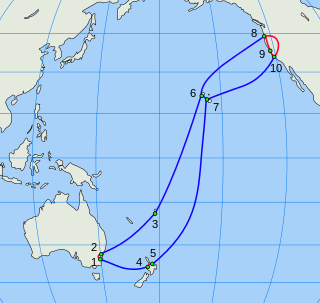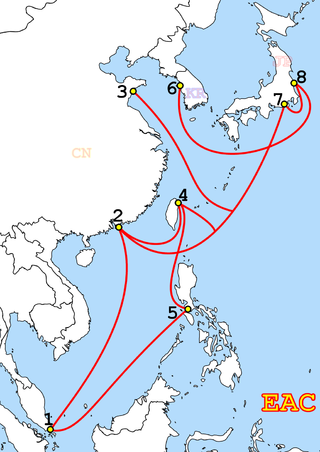
The Southern Cross Cable is a trans-Pacific network of telecommunications cables commissioned in 2000. The network is operated by the Bermuda-registered company Southern Cross Cables Limited. The network has 28,900 km (18,000 mi) of submarine and 1,600 km (990 mi) of terrestrial fiber optic cables, all which operate in a triple-ring configuration. Initially, each cable had a bandwidth capacity of 120 gigabit/s. Southern Cross offers capacity services from 100M/STM-1 to 100 Gbit/s OTU-4, including 1G, 10G and 40G Ethernet Private Line services.
The Eastern Africa Submarine Cable System (EASSy) is an undersea fibre optic cable system connecting countries in Eastern Africa to the rest of the world.

South East Asia–Middle East–Western Europe 4 is an optical fibre submarine communications cable system that carries telecommunications between Singapore, Malaysia, Thailand, Bangladesh, India, Sri Lanka, Pakistan, United Arab Emirates, Saudi Arabia, Egypt, Italy, Tunisia, Algeria and France.
APCN 2 or Asia-Pacific Cable Network 2 is a submarine telecommunications cable linking several countries in the Asia-Pacific region.

EAC-C2C is a submarine telecommunications cable system interconnecting several countries in Asia, the Pacific, and the United States. It is a merger of the former EAC and C2C cable systems. The merger occurred in 2007 by Asia Netcom, and the cable system is now owned/operated by Pacnet. Pacnet was acquired by the Australian telecommunications company Telstra in 2015.
i2i is a submarine telecommunications cable connecting Chennai, India, and Tuas, Singapore. It was completed in April 2002 and is fully owned by Bharti Airtel after Singtel divested its interest in 2007.

TPE or Trans-Pacific Express is a submarine telecommunications cable linking China, South Korea, Taiwan, Japan, and the United States. The line is a US$500 million joint venture between 6 telecommunication companies China Telecom, China Netcom, China Unicom, Chunghwa Telecom, Korea Telecom, and Verizon Communications. Ownership of the cable is evenly split between the 6 participants. Construction of this 11,000 miles line was completed in September 2008, and the Japan branch was completed in January 2010.
I-ME-WE is a 12,091-kilometre (7,513 mi) submarine communications cable system linking Europe and India via the Middle East. At launch, the design capacity was 3.84 Tbit/s, but after upgrades by Mitsubishi Electric in 2016, the new design capacity was rated at 5.6 Tbit/s. The cable entered service in December 2010.
The Matrix Cable System (MCS) is a submarine telecommunications cable linking Indonesia and Singapore with a 2nd phase to Landing at Perth, Australia. It was constructed by Tyco.
The Main One Cable is a submarine communications cable stretching from Portugal to South Africa with landings along the route in various west African countries. On April 28, 2008, it was announced that Main Street Technologies has awarded a turnkey supply contract for the Main One Cable System to Tyco Telecommunications.
TRANSPAC or Trans-pacific cable (TPC) is a series of undersea cables under the Pacific Ocean.

Pacnet was a global telecommunications service provider between 2008 and 2015. It was formed from the operational merger of Asia Netcom and Pacific Internet on 8 January 2008. It was owned by a private investor group comprising Ashmore Investment Management Limited, Spinnaker Capital Limited and Clearwater Capital Partners. Its acquisition by the Australian telecommunications company Telstra was announced at the end of 2014, and completed in April 2015.
Europe India Gateway (EIG) is a submarine communications cable system that connects the U.K., Portugal, Gibraltar, Monaco, France, Libya, Egypt, Saudi Arabia, Djibouti, Oman, United Arab Emirates, and India.
FASTER is a trans-Pacific submarine communications cable that went live during the last week of June 2016. The cable has a total length of approximately 11,629 km and a capacity of 60Tb/s.
South East Asia–Middle East–Western Europe 5 is an optical fibre submarine communications cable system that carries telecommunications between Singapore and France.
West Indian Ocean Cable Company (WIOCC) operates as a wholesaler, providing capacity to international telecoms, cloud operators, content providers and internet service providers within and out of Africa. WIOCC offers carriers connectivity to over 550 locations across 30 African countries – utilising more than 75,000 km (47,000 mi) of terrestrial fibre and 200,000 km (120,000 mi) of submarine fibre-optic cable. WIOCC's international network reach currently extends to 100 cities in 29 countries in Europe and more than 700 cities in 70 countries globally.

MAREA is a 6,605 km long transatlantic communications cable connecting the United States with Spain. Owned and funded by Microsoft and Facebook, but constructed and operated by Telxius, a subsidiary of the Spanish telecom company Telefónica, it is the "highest-capacity submarine cable in the world" with a system design capacity of 200 terabits per second as of 2019.
Asia-Africa-Europe 1 (AAE-1) is a 25,000 km submarine communications cable system from South East Asia to Europe across Egypt, connecting Hong Kong, Vietnam, Cambodia, Malaysia, Singapore, Thailand, Myanmar, India, Pakistan, Oman, UAE, Qatar, Yemen, Djibouti, Saudi Arabia, Egypt, Greece, Italy, and France. The AAE-1 cable has capacity of at least 40 terabits per second (Tbit/s) to supply the broadband market across Asia, Africa and Europe. In July 2017, it was launched for commercial services and is the longest submarine cable system in over a decade.
Dunant is a private 250 Tbit/s 6,600 kilometre transatlantic communications cable that connects the United States with France (Saint-Hilaire-de-Riez). Named for Henry Dunant, it was announced by Google in 2018 and went live in 2020.
South East Asia–Middle East–Western Europe 6 is an in-progress optical fibre submarine communications cable system that would carry telecommunications between Southeast Asia, the Middle East, and Western Europe. Construction began in early 2022. It is expected to be operational in the first quarter of 2025 The expected cable length is 19,200 km and it has a design capacity of 126 Tbit/s, using SDM technology.






